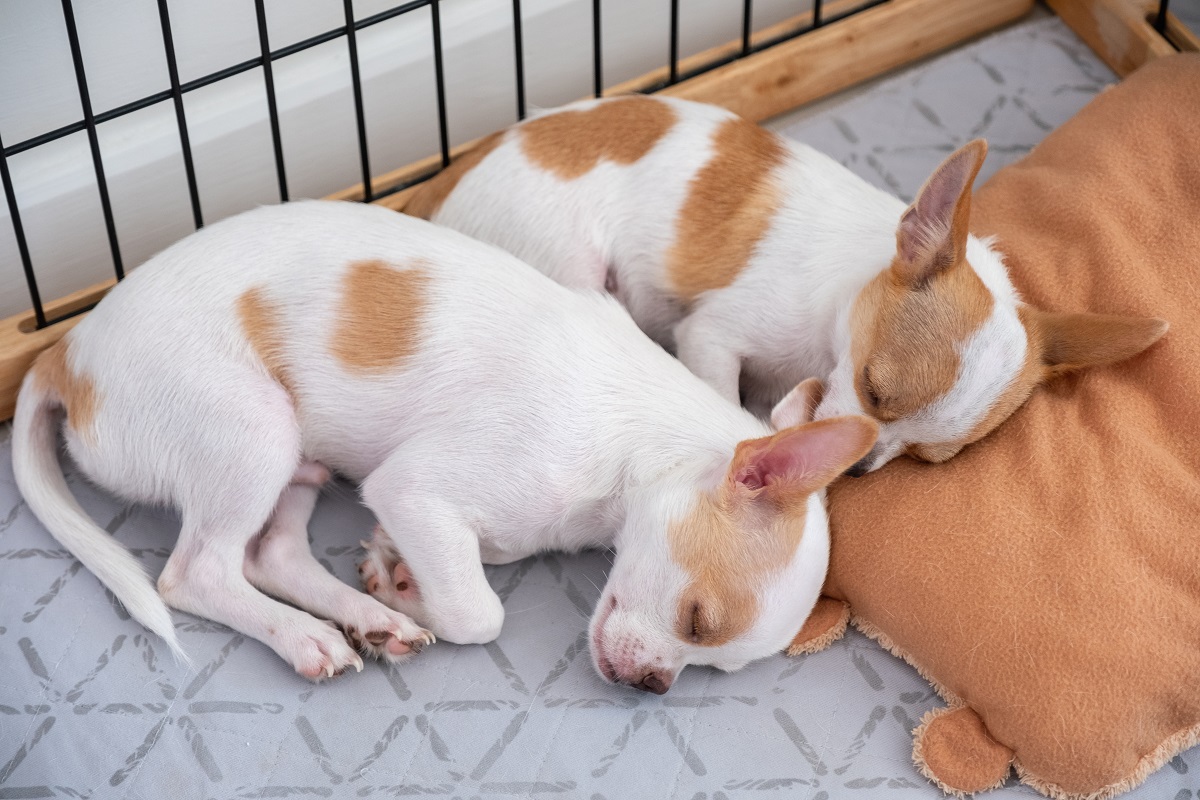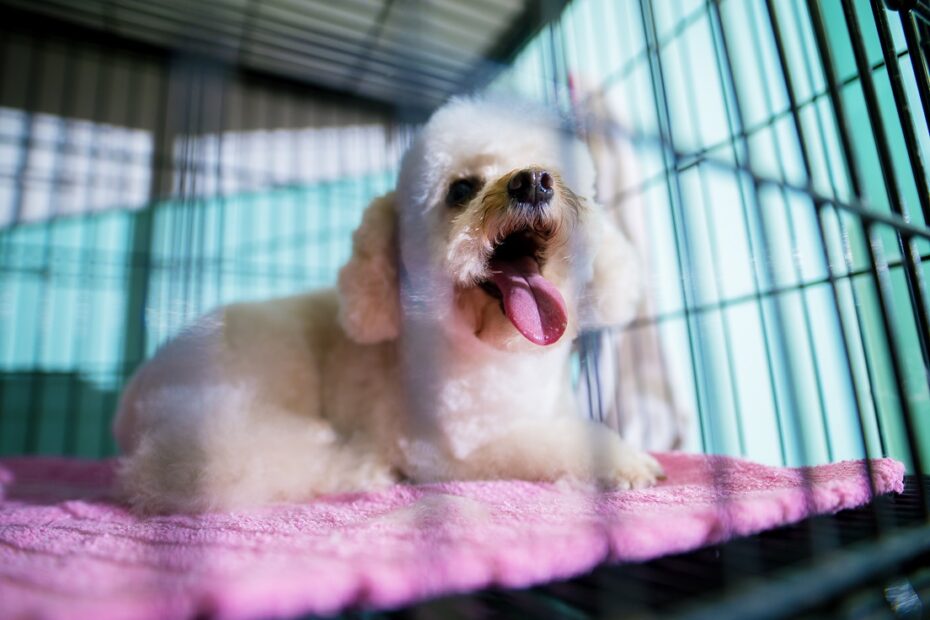The sound of a puppy whining in a crate is enough to break your heart. Or at least enough to open the door and never use the crate again.
But should you go with what your heart is telling you? Or should you follow your head and persevere?
Ultimately, only you can make the decision. Crates are by no means an essential item in your puppy’s life. Whether you use one or not, they’ll survive.
But while they’re not essential, they can be incredibly useful, whether it’s in helping with potty training or providing a calm sanctuary for your puppy to retreat to.
Before reaching any conclusions, try to figure out why your puppy is whining. In many cases, it’s for a simple reason with a simple remedy.
Perhaps they’re feeling overwhelmed. Maybe they’re bored. It could just be that they need the bathroom.
Ultimately, not all puppies are going to take to a crate like a duck to water.
Some won’t understand why their freedom has suddenly been reined in. Others might feel trapped and afraid.
And while they’re feeling that way, you can expect plenty of whining, barking, and pitiful looks.
But here’s the good news…
With the right technique, all of those problems can be overcome. The first step in the process is figuring out why they’re whining.
From there, you can start working on making them feel safe, secure, and happy in their crate.
In the meantime, there’s one thing you can start working on straight away.
Calmness.
Your super excitable, bouncy pup might not know the meaning of the word now, but I guarantee that if you follow these 5 step-by-step calming exercises from Dan Abdelnoor over at The Online Dog Trainer, they soon will. (see video below)
Once you teach your pup how to take control of their emotions, they’ll naturally start approaching life (and their crate) in a calmer, more considered way.
(video will open in a new window)
Why Do Puppies Whine?
Your puppy is probably experiencing a whole heap of emotions right now.
They’re getting used to their new home and their new family; adjusting to being away from their mother and siblings; learning new rules, seeing new sights, and discovering new things.
If all that wasn’t enough, now they’ve got a big shiny crate to deal with.
With so much going on, it’s only natural for them to feel a little overwhelmed.
But why exactly do they start crying the moment they go into their crate?
Although every dog is different, most crate-based whining comes down to one or more of the following…
They’re Frustrated
After weeks of being able to sleep wherever they want and go wherever they choose, your pup’s freedom has suddenly been reined in.
Over time, they ”ll come to see their crate as a source of safety and sanctuary. But for now, it’s the thing that’s clipped their wings.
The crate is what’s stopping them from running around and going where they please. It’s the thing that’s making them having to hold their bladder rather than release it at a whim.
It’s what’s standing between them and you.
Basically, it’s annoying, and it’s making your pup feel frustrated.
How do they vent that frustration?
You guessed… whining, barking, and crying until someone eventually relents and lets them out.
They’re Scared
Puppies might be young, but their memories are long. If they’ve had a poor prior experience with a crate or if their introduction to it was rushed, it might have become a source of fear.
Once your puppy develops negative associations with a crate, they’ll do anything they can to get away from it, including crying desperately in the hope someone lets them out.
A puppy who cries out of fear is very different from one who cries out of frustration.
A puppy who cries out of frustration will bark or cry for a minute or so, play for a little while, and then bark and cry again.
The moment you let them out, they’ll go back to their normal, happy selves.
A puppy who cries in fear will cry constantly.
They may even display other fear-based behaviors such as panting, trembling, drooling, and scratching.
When you let them out, they’ll take a while to get back to normal.
In some pups, the fear is based entirely around the crate. In others, it could be a more worrying sign of generalized separation anxiety.
This condition makes dogs extremely anxious and stressed whenever they’re away from their owner, even if for brief periods.
They Need to Pee
Puppies hate going to the toilet in the same place they sleep. If they need to go, they’d far rather cry to draw your attention than simply let loose with the waterworks.
If they go into their crate happily enough but wake up crying a few hours later, they might just need to pay a visit to the yard.
Related Post: How To Toilet Train A Puppy In 7 Days – The Quick & Easy Way

They’re Too Tired to Sleep
Puppies like to play. They like it so much, they’ll do anything they can to avoid breaking away from the fun for a nap.
But naps aren’t a choice: they’re essential.
If your pup goes to bed over-tired and wired, you can kiss goodbye to a peaceful night.
They’re Hungry
Don’t underestimate just how hangry a pup can get if it’s been too long since their last meal.
Although feeding them right before bedtime isn’t a good idea (not unless you want to make a midnight dash to the yard, in any case), neither is feeding them their last snack too early.
If your pup wakes up with a rumbly tummy and a raging appetite, you can bet it won’t take them long to let you know about it.
They’re Lonely
For the first time in your puppy’s young life, they haven’t got their mother and siblings around them. And that hurts.
With time, they’ll adjust and come to see you as their new family.
But for now, they’re feeling the pain of not having their mother to comfort them or their brothers and sisters to romp around with.
Scared and lonely, they use their voices to call out to their old pack in the hope of being reunited.
It’s sad, it’s distressing, and it will pass.
They’re Scared of the Dark
A fear of the dark can lead to some unsettling behavior, including anxiety-induced elimination, pacing, drooling, and excess vocalization.
Some dogs will even risk injury to themselves in an attempt to get away from the darkened area.
In most cases, the anxiety is linked to separation rather than the dark itself.
However, it can occasionally be linked to a vision defect, in which case prompt veterinary intervention is needed.

How to Stop a Dog Whining in the Crate
If your pup spends more time crying in their crate than they do sleeping in it, it’s time for a change.
The first step towards positive progress is to figure out exactly what’s making them cry.
Once you do that, you can start moving forward with some of the following techniques.
Reintroduce Them to the Crate
A rushed introduction isn’t the way to make a positive first impression.
If your pup’s first experience of the crate was hurried or otherwise unpleasant. They might have developed negative associations with it.
If that’s the case, you’ll need to stop, rewind, and introduce them to it all over again.
Remember, if you try and rush these next steps, your dog will never see the crate as anything other than a source of fear.
Go slowly. And if they start to show any signs of fear, dial things back.
Some people prefer to remove the door of the crate completely while their puppy acclimatizes.
If you’d rather not go that far, simply avoid shutting the door during the initial stages of training. It may help to use a prop to stop it accidentally swinging shut while your puppy’s inside.
To get the introductions off to a good start, begin by feeding your pup at the edge of the crate.
If they’re comfortable enough to poke their head through the door, position the bowl just inside the entrance. If they’re not, position it directly outside.
Once they’re eating happily by the crate, encourage them to venture inside by throwing some of their favorite treats just inside the entrance.
Gradually work on throwing the treats further and further back inside the crate. You can then start handing them treats between the bars to encourage them to stay inside longer.
Once they’re fully comfortable with the crate, put a tasty bone inside and shut the door. Make sure they’re watching as you do it.
When they approach the crate and ask to be let in, open the door before shutting it after them.
Once they’ve finished eating, let them back out.
Work on slowly increasing the length of time your puppy spends inside the crate. If they start to show signs of being anxious, backtrack.
It may take several weeks or even months before your puppy is fully comfortable with the crate.
So be patient. With time, they’ll get there.
To help the process alone, work on these 5 step-by-step calming exercises with your pup whenever possible.
The calmer and more controlled they are in general, the calmer and more controlled they’ll be around the crate.

Get Cozy
The more comfortable you can make the crate, the happier your pup will be about spending time in it.
Position the crate in a quiet spot away from the hustle and bustle of the house and keep it away from any direct heat sources or drafts.
Next, lay a cozy bed on its base and add a few blankets for your pup to snuggle up in.
As dogs are ruled by their noses, consider leaving one of your old sweaters or t-shirts in the crate.
If your pup wakes up in the night, your scent will help reassure and comfort them.
Add Some Distractions
Puppies like to have something to do all the time. If you stick them in a crate with nothing to keep them occupied, it’s only natural for them to kick up a fuss.
Stop boredom crying in its tracks by leaving them with something to chew on.
A good, sturdy chew toy will keep them nicely entertained for hours. Relieving them of the boredom and frustration that can all too often end in a howling session.
Soothe Their Nerves
Crate or no crate, the first few weeks or even months in a new home can be unsettling for a puppy.
With time, they’ll calm down and become fully at ease with their new surroundings. Until then, there’s plenty of ways you can help them feel more comfortable.
Calming pheromones, relaxing music, and even aromatherapy can all help soothe frazzled nerves. Now’s also a great time to knuckle down and introduce these 5 step-by-step calming exercises into their routine.
If your dog is calm and relaxed before going into their crate at night, they’ll be more inclined to snuggle down and sleep than to cry.
Closing Thoughts
A crate can be an enormous source of comfort and security to a dog. But some things take time, and crate training is most definitely one of those.
Don’t give up at the first hurdle. While some dogs adapt easily to a crate, others need longer. With time, patience, and plenty of reassurance, they’ll get there in the end.

